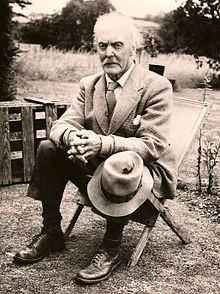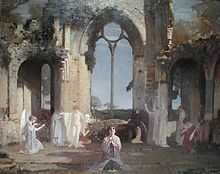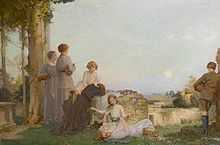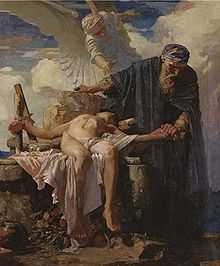Fred Appleyard
| Fred Appleyard | |
|---|---|
 | |
| Born |
Frederick Appleyard 9 September 1874 Middlesbrough |
| Died |
22 February 1963 (aged 88) Itchen Stoke, Alfreston, Hampshire |
| Nationality | British |
| Known for | Painter |
Fred Appleyard (1874 – 1963) was a British landscape artist. He had 41 works exhibited during his lifetime by the Royal Academy and painted the mural 'Spring driving out Winter' in the Academy Restaurant.
Appleyard was born in Middlesbrough, England on 9 September 1874, the son of Isaac Appleyard, an iron-merchant.
Having received his formal education at Scarborough, he attended Scarborough School of Art under the genre and landscape painter Albert Strange. It was at the Scarborough School of Art that he met Harry Watson, the two were to remain lifelong friends. He then proceeded to the National Art Training School at South Kensington, and from there to the Royal Academy Schools, which he entered on 27 July 1897 at the late age of twenty-two. He was recommended to the R.A. by John Sparkes. He was awarded the Turner Gold Medal, the Creswick Prize for landscape, the Landseer Scholarship and others.

He carried out mural decorations for the Royal Academy Refreshment Room in 1903, St Mark's, North Audley Street, two large paintings in Nottingham General Hospital and Church of SS Peter and Paul, Pickering, Yorkshire. He worked in South Africa 1910–12. During the 1914–18 war worked at the Woolwich Arsenal. Exhibited at the R.A. 1900–35 and the R.W.A. from 1918 until c. 1950.
He was a painter of subject pictures, landscapes, portraits and allegorical compositions of a decorative kind associated with English Impressionism. He exhibited widely during his lifetime, at the Royal Academy (forty-one works), the Walker Art Gallery, Liverpool, (thirteen works), and the Glasgow Institute of Fine Arts. He was at one time a regular exhibitor at The Royal Academy of both oil paintings and watercolours and at the Royal West of England Academy of which he was elected a member in 1926. Much of Fred Appleyard's work had a decorative inclination and he executed several wall paintings, including "Spring Driving Away Winter" over the door of the Refreshment Room at the Royal Academy which was commissioned by the President and Council.

He is represented at The Tate Gallery by an oil painting entitled "A Secret", a Chantrey Bequest purchase from The Royal Academy Exhibition of 1915. His works are represented in museums at the Victoria Art Gallery, Bath, in Bristol, Rochdale and Grahamstown, South Africa. The painting "Old Walls" is hanging at the Mansion House in Doncaster.
Fred Appleyard is known chiefly for his scenes depicting families of obviously substantial means in outdoor settings, often incorporating ruins in his compositions. He used a dappling technique which was ideally suited to his frequent depiction of sunlight broken through trees. He was also fond of incorporating children into his work.
It was after the 1914-18 war that the big change in his life took place, he left London and settled in the Hampshire village of Itchen Stoke where he lived for nearly fifty years as a true artist despising money and fame, having to let his house to fishermen from the Stock Exchange to pay his rates and selling his Turner Gold Medal to get electricity put in his house.
This combination of an academic mind linked with that of the artist philosopher produced a rare set of beautiful paintings, English impressionism at its best.

Lived at Alresford, Hampshire, and died there 22 February 1963.
He was the brother-in-law of fellow artist Christopher Williams.[1]
Notes
- ↑ Williams, Jeremiah (ed.) (1955). "Christopher Williams RBA : an account of his life and appreciations of his work" (in English). Caernafon: Delyn Press.
Resources
- Twentieth Century Painters and Sculptors. By Frances Spalding. Suffolk, England: Antique Collectors' Club, 1990.
External links
- A Secret - Tate Gallery
- Paddlers - Royal West of England Academy
- Pergola
- Ruined Rocks
- River Scene
- Royal Academy: Restaurant and café
- Lay not thine hand upon the lad
|